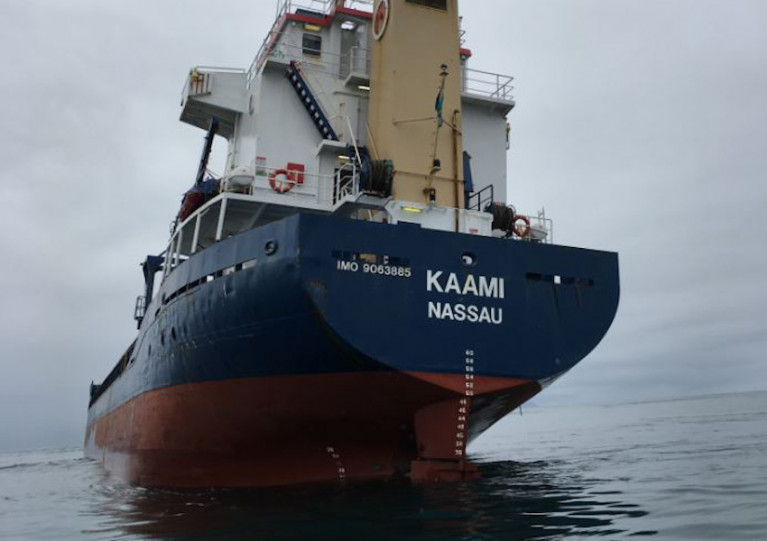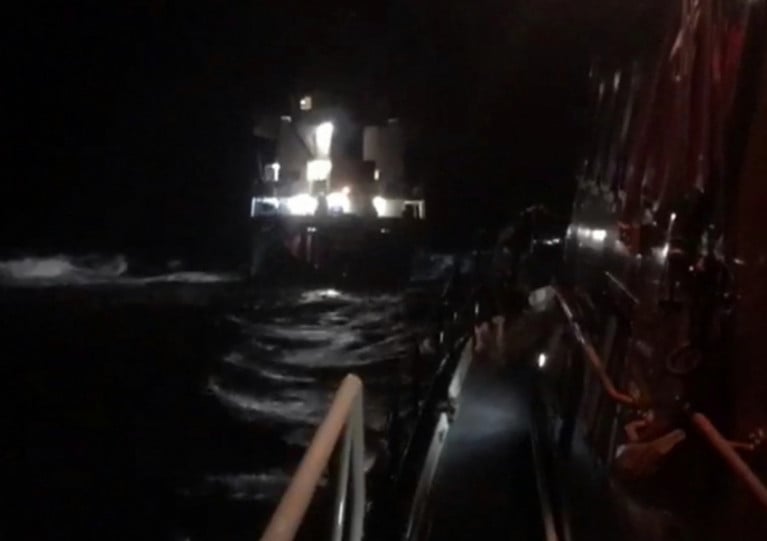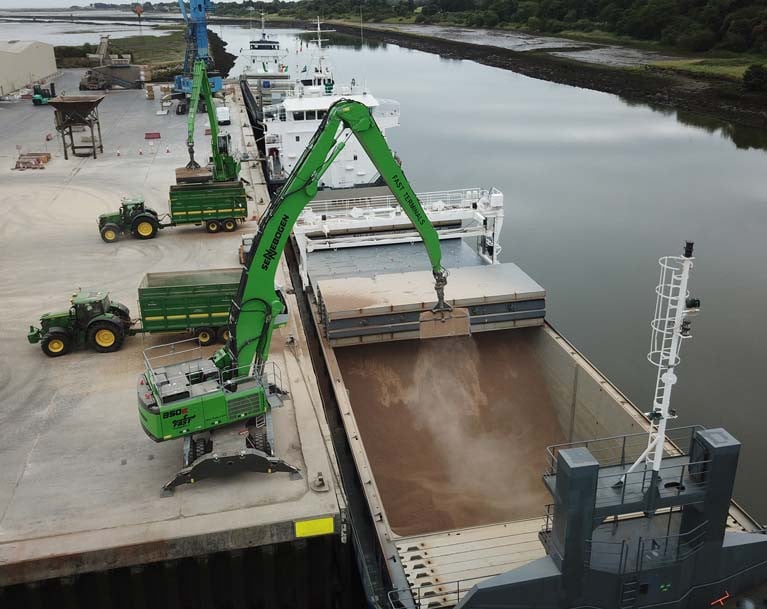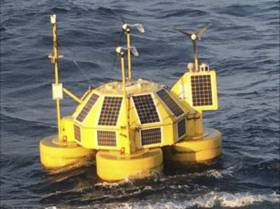Displaying items by tag: Drogheda Port
Work Continues To Remove Cargo From Vessel Aground Off Scotland After Sailing From Drogheda
Work continues at pace to remove cargo from the MV Kaami which ran aground off Skye in western Scotland after sailing from Drogheda Port last month.
A further 22 skips of cargo were removed yesterday (Monday 20 April), meaning a total of 160 skips worth of cargo have now been taken ashore.
Divers have also now been able to access the hold of the vessel to begin internal damage assessment.
The ship remains aground in the Minch between Skye and Lewis.
Stephan Hennig, the Secretary of State’s Representative for Maritime Salvage and Intervention, said: “Thanks to good weather and sea conditions, progress is being made swiftly.
“The removal of so much cargo now means we’re getting closer to the next phase of the salvage which will focus on assessing the internal damage and attempting to temporarily repair damaged sections of the ship.”
As previously reported on Afloat.ie, an exclusion zone had been stablished around the Nassau-registered cargo ship after it ran aground at Eugenie Rock within days of leaving Drogheda Port on 21 March.
The vessel’s eight Russian crew were rescued from the spot some six nautical miles north-west of Duntulm on Skye.
Exclusion Zone Set Up At Cargo Ship Out Of Drogheda That Ran Aground In Western Scotland
An exclusion zone was set up around a cargo ship out of Drogheda that ran aground in Scotland’s Hebrides earlier this week, as it was battered by persisting storm conditions.
As previously reported on Afloat.ie, eight crew were airlifted from the MV Kaami on Monday (23 March) after it grounded on a reef known locally as Eugenie Rock, some six nautical miles off the Isle of Skye.
The MV Kaami had left Drogheda Port less than two days previously, en route for Slite in Sweden, with a cargo of refuse-derives fuel (RDF) in pellet form.
The Press and Journal reports that a salvage team arrived on Tuesday (24 March) to inspect the abandoned vessel, while the tug Ievoli Black remained at the scene on guard.
Eight Crew Airlifted From Cargo Ship Aground Off Skye
Eight crew were rescued from a cargo ship out of Drogheda that ran aground off the Isle of Skye in Scotland’s Inner Hebrides early yesterday morning (Monday 23 March).
The MV Kaami had left Drogheda Port on the evening of Saturday 21 March and was due to arrive in Slite, Sweden this weekend.
But the 90m cargo vessel ran aground in The Minch at what’s known locally as Eugenie Rock, about six nautical miles north-west of Duntulm on Skye.
Portree RNLI’s lifeboat was launched at 2.24am yesterday morning in response to a MayDay call from the MV Kaami, as did the Emergency Towing Vessel Ievoli Black and the Pharos, a Northern Lighthouse Board buoy-laying vessel.
The duty Stornoway Coastguard rescue helicopter arrived on scene, where weather conditions has a Force 8 southerly wind with a rough sea state, and began to airlift eight of the Russian crew to Stornoway. No injuries were reported.
Drogheda Students Recognised at Sail Training Awards
The “Drogheda Sail Training Bursary” was once again highlighted at the Annual Sail Training Ireland Awards Ceremony last week in the Mansion House. The CEO of Sail Training Ireland, Mr. Darragh Sheridan acknowledged the Drogheda bursary scheme as the first of its kind back in 2013, encouraging many other port towns and cities to follow suit. Fast forward seven years and there are 8 of these local bursary schemes operating throughout Ireland in association with the national charity, Sail Training Ireland.
It is true to say pre-2013 Maritime facilities for such opportunities as this in Drogheda were non-existent, so the Drogheda Port Company set out to change that through Sail Training. Since then 140 local teens have been gutsy enough to experience this influential sailing experience that often has a profoundly positive effect on their outlook on life and career choices. Some trainees have progressed to longer voyages on bigger tall ships, while others are now sitting on the Sail Training Ireland Youth Council and even pursuing maritime careers in the Navy. These developments are a testament of how much this Drogheda Sail Training youth development program has grown since its maiden voyage back in 2013.
At last week’s Awards Ceremony, local students, Erin Englishby of Colaiste na Hinse, Bettystown and Ronan Collins of St. Joseph’s C.B.S, Drogheda were both presented with the Perpetual Trophy for ‘Outstanding Trainee’ on their respective voyages in June 2019. Their vessel Captain, Mr. Peter Scallan who presented these awards, described these trainees as valuable, committed leaders who enriched the experience of all onboard. Both students are keen to continue sailing and are hopeful of upskilling on progression voyages later this year.
The continued support of the bursary sponsors is the key driver of this initiative; Irish Cement, Fast Terminals, Louth County Council and Drogheda Port Company make this possible.
Drogheda Port Records Record Year
Drogheda Port Company handled over 1.6 million tonnes of cargo in 2019. This is the third consecutive fiscal year in which the port has set a new cargo tonnage record. The port has been outperforming the Irish port sector in terms of year on year throughput growth for the last number of years.
The MV Nordic Diana stevedored by Fast Terminals imported a cargo of timber from Raahe in Finland on the 31st December establishing the new port record.
“2019 was marked by a robust economy coupled with strong performances in the Agri and construction sectors,” Paul Fleming Drogheda Port Chief Executive, commented. “These record volumes highlight the need for the continued development of the port and its facilities and we are currently completing a masterplan to inform the development of the port over the next 30 years which will be published later this year.” The record throughput has been achieved in a year which saw major restructuring within the port and improvements in operational efficiencies.
The port company completed a number of mergers and acquisitions positioning itself as the leading full-service port in Ireland. The outlook for 2020 continues to be strong in spite of Brexit uncertainty. As a major local employer, the company is planning a number of cargo storage projects in 2020 to increase the ports throughput capabilities as the port continues to provide a central role in facilitating Irelands open trading economy and is key in supporting a number of the regions major employers to reach their markets.
A Metocean Buoy will be towed out from Drogheda Port and deployed at the Oriel Windfarm, Outer Dundalk Bay according to the Department of Transport, Tourism & Sport.
The duration of deployment is 1 day, and it will be carried out in the two-week period 11/10/19 to 25/10/19, subject to weather conditions.
The Survey will involve the deployment of a Floating Lidar Metocean Buoy. The Buoy is yellow in colour with a St. Andrew Cross on top.
The buoy has an area of 4 x 4 m and height of approx. 3 m above the waterline.
The buoy is equipped with a IALA yellow light, which flashes at a rate of 5 flashes every 20 seconds (Fl(5) Y 20s). The light has a range of 4 nm.
The surveys will be completed using Vessel “AMS Retriever” (callsign: MEHI8), which is a versatile multi-purpose, shallow draft tug.
Whilst transiting from Drogheda Port on the River Boyne, the “AMS Retriever” will have the Metocean Buoy secured against the stern of the vessel. When the AMS Retriever reaches open water, the buoy will be towed approximately 30 metres astern at a maximum speed of 4 kts.
During deployment of the Metocean Buoy at Oriel Windfarm the vessel will be restricted in its ability to manoeuvre.
Drogheda Teens Among Sail Training Awardees
Last Saturday, (2nd February) Sail Training Ireland held their Annual Awards event at the Mansion House in Dublin. The annual awards, as reported by Afloat.ie here recognise excellence, achievement and outstanding contribution in the sailing community at all levels. The Drogheda Sail Training Bursary has been a central element in the award ceremony for a number of years and two special recognition awards are made to Drogheda Trainees who participate in the local scheme.
Two specially commissioned perpetual trophies are awarded each year at the prestigious award ceremony. Mayor of Drogheda, Frank Godfrey and the Lord Mayor of Dublin Nial Ring were in attendance among other regional and national dignitaries to mark the occasion.
The 2018 trainees included young people from residential care homes, Garda Diversion Projects, Sea Scouts, Youth and Community groups and Schools, drug rehabilitation programmes, asylum seekers and immigrants and young people with visual, hearing and physical impairments from across the island of Ireland.
Two award recipients were Drogheda teens, Shauna Murphy of the Sacred Heart School and Sinead O’Byrne of the Grammar School. Drogheda Mayor Frank Godfrey and Drogheda Port Company Director Ciaran Callan presented the girls with a perpetual trophy each for ‘Outstanding Trainee’ on their respective voyages as part of the 2018 Drogheda Sail Training Bursary. Both of these transition year trainees displayed remarkable resilience and never refused a chance to acquire new skills and gain a greater self-belief.
"Drogheda Sail Training Bursary has funded over 100 local trainees"
Sail Training Ireland’s chairman Seamus Mc Loughlin singled out the ‘Drogheda Sail Training Bursary’ as the very first regional sail training scheme, which since 2013 has funded over 100 local trainees to participate in sail training voyages and bring a positive focus back to the maritime town of Drogheda and its famous River Boyne. Nessa Lally of Drogheda Port thanked the Mayor of Drogheda for his attendance and she emphasised the importance and the strong continued support of the Drogheda bursary sponsors, who are; Irish Cement, Fast Terminals, Louth County Council and Drogheda Port Company.
The Drogheda Sail Training Bursary programme for 2019 is now open, voyages are open to 18-23-year-olds from any nominating schools, youth or community groups, diversion projects and others. If you are seeking a life-changing experience and think you could benefit from this wonderful opportunity please get in touch as we are funding 20 trainee places this year.
Drogheda Port Works on Master Plan 2020-2050
Drogheda Port Company, supported by leading experts from Brady Shipman Martin, are working on a Master Plan for the future of the Port that will run from 2020-2050.
Earlier this year, Drogheda Port Company published an Issues Paper and invited members of the public, business, state agencies, regulatory bodies and government to make submissions. This week the preliminary findings of the submissions were announced by Paul Fleming, CEO of Drogheda Port Company.
“We are delighted with the level of interest and submissions to the Issues Paper. The Masterplan we are developing will run from 2020-2050 and so it was really important for us to take on board suggestions and observations from the community and stakeholders. We received a really strong response and we thank those individuals and organisations who took the time to participate in this consultation process.”
Paul Fleming continued “Some of the key issues raised in the submissions include road access to the port, deep-water berths, environmental protection, requirement for additional land, warehousing and storage and recognising the Port as a valuable economic asset. The role of the Port in the urban regeneration of Drogheda came to the fore in submissions that discussed relocating Port operations from the Town Quays to further downstream. These, and many other issues, will all be addressed in our master-planning process and it is interesting to note that our priorities and those of the public and stakeholders are largely aligned.”
Drogheda Port is one of the key drivers of economic activity and development in the north-east. The Port, and the work that it facilitates, supports imports, exports, and job creation. As a critical part of the infrastructure of this region, it is vital that the Port plans ahead and continues to provide facilities and services to meet the needs of the eastern region into the future.
Submissions also recognised the importance of Drogheda Port as a facilitator of employment and competitiveness for the region. Others highlighted the role of the Port in tourism and marine leisure activity, and some challenged the Port to examine issues of off-shore renewable energy.
Port Chairman Joe Hiney stated: “I would like to acknowledge the constructive feedback received in the master planning process, including on the topic of external port development. This is timely as the national port industry is actively examining port infrastructure demand and supply issues in terms of changing market conditions in the various cargo sectors, including Brexit impacts, and capacity constraints at existing east coast ports. In the case of Drogheda we have identified demand for deep water and niche cargo services on the east coast in addition to the planned expansion of operations in the Boyne estuary.”
He continued “We, therefore, put our external project subsidiary (“Bremore”) on the market and following considerable commercial interest have signed a development Memorandum of Understanding with a substantial private partner. This development project is focussed on serving the growing Irish port service market, on maintaining a competitive landscape on the east coast, and ensuring that Drogheda Port Company continues to grow in a sustainable manner.”
Paul Fleming concluded “This has been a very worthwhile, informative and educational phase of our master planning process. Our role in Drogheda Port Company is to ensure that strategic, economic, community and environmental factors are all considered and carefully factored into the long-term plan for the Port. Now that this stage of the process has been completed, we will revert to an intensive internal planning phase and intend to publish the draft Master Plan early in 2019 with the final Master Plan being completed by mid-year.”
One of the most dramatic marine visual sights in the country is along Drogheda Port’s town quays, where you can see the backdrop of the Boyne Viaduct which carries the main rail line from Dublin northwards.
It spans the historic River Boyne which has been known since ancient times …The Greek geographer PTOLEMY is said to have drawn a map of Ireland in the second century which included the Boyne…
The port has been crucial to the newspaper industry, as the major import centre for newsprint. Having reported quite a bit of its development over the years, one aspect which appeared to me not to be high on the priority list was the leisure sector, for which Drogheda would not be traditionally known.
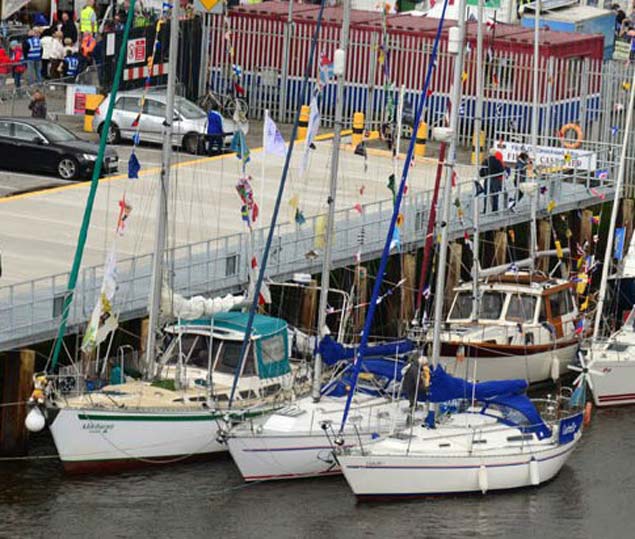 Fiddle Case Pier at Drogheda Port
Fiddle Case Pier at Drogheda Port
There is a change in that aspect and its welcome. The Port Company tells me that its intention is to become an East Coast boating location in addition to its commercial development. A few developments are coming together in that regard and will be highlighted this weekend.
"The Port Company tells me that its intention is to become an East Coast boating location in addition to its commercial development"
The Fiddle Case Pier is one of the most unusual names I’ve ever heard for a pier. There was an original Fiddle Case Pier constructed in the 1850s in the port, but the origin of the name seems to lack specific records, so I’m told. The 40-metre Fiddle Case Pier there now is 400 metres upstream of that dramatic Boyne Viaduct vista and past the shipping quays.
A joint venture between the port and Louth County Council, it’s intended to provide for expansion, depending upon demand, which could increase with the opening up of maritime access to the Boyne Valley upon which the Boyne Navigation Group has been doing tremendous work to enable boats make their way up the Boyne.
This weekend the port will host the annual Maritime Festival and another piece of history when the French Navy visits for the first time. With Tall Ships and leisure craft gathered it will highlight the leisure aspect with the commercial at a time when the Port is at work on a Master Plan for the next twenty years or so and has put its subsidiary Bremore Port up for sale.
Big changes then at Drogheda and a port which is putting more emphasis on the leisure marine in the context of port development.
The award-winning Irish Maritime festival is back. Taking place this weekend (16-17th June) in Drogheda Port, it’s a super-sized maritime celebration and it suitable for all ages. Hosted by Louth County Council and Drogheda Port Company in conjunction with Virgin Media, the event sees Drogheda’s busy working port converted into a weekend-long festival of all things maritime.
Parade of Sail: Friday 15th June, 12 noon
The whole event kicks off on Friday afternoon as the beautiful ships sailing to Drogheda Port. The ships muster at the mouth of the Boyne at noon and sail in a procession right up to the Town Quays. The best vantage point Is out at the Maiden’s Tower in Mornington where spectators have a birds-eye view of all the ships arriving.
 Drogheda's Magnificent Maritime Parade of Sail
Drogheda's Magnificent Maritime Parade of Sail
Tall Ships in Drogheda
There is a fantastic array of ships to look forward to this year. The Tall Ships include The Phoenix, The Earl of Pembroke, Johanna Lucrectia, The Keewaydin. They will be joined by three French Naval Vessels, the Altair, the Antares and the Aldebaran, each of whom will be available to board over the weekend.
"The Tall Ships include The Phoenix, The Earl of Pembroke, Johanna Lucrectia, The Keewaydin"
Back by very, very popular demand is the Liverpool-based tugboat the Brocklebank and her crew. They were such a hit last year, with queues to visit them both days, that it was just essential to bring them back again this year.
All ships will be open from 12.30 to 4.30pm, but it’s worth getting there early to ensure you don’t miss out. Festival gates open at 11.00am daily.
The Stowaway Sessions
(Friday 15th June and Saturday 16th June, 7.30pm)
2017 saw the inaugural “Stowaway Sessions” that the Irish Maritime Festival. Each night, the deck of the Earl of Pembroke played host to an intimate music gig with Drogheda’s historic Viaduct as the backdrop. 2018 sees the Stowaway Sessions return with two more incredible gigs – Friday night The Lost Brothers and Eve Belle and Saturday night Declan O’Rourke with Pilgrim Street. Tickets sold out in record time, but watch out for the 2019 progamme that will be announced in mid-April next year – the Stowaway Sessions are truly special gigs.
Maritime Education Zone
The Irish Maritime festival proper commences at 11am on Saturday morning as gates open to the public. Discover the Maritime Learning Zone which includes displays and crews from the RNLI, Inland Waterways Ireland, the Irish Coast Guard and many others. Enjoy boat displays from Boyne Boats, Power Kites and Sand Yachts. Learn all about the sea and measures to protect our seas with the crew from 'Seastainability'.
"The Drogheda Sail Training Bursary will give two more teams of youngsters from Drogheda the chance to learn to sail"
Sailors in the Making
The Drogheda Sail Training Bursary will give two more teams of youngsters from Drogheda the chance to learn to sail as part of the Irish Maritime Festival 2018. Departing in the Sail Training vessel, The Brian Boru, each team will take part in a week-long voyage at sea to learn how to sail. The adventure not only teaches sailing skills but valuable life skills of teamwork, communications and compromise. This award-winning scheme has trained over 100 young sailors in the past 5 years.
Boyne Swim
The challenging Boyne Swim is back. Cheer on the 200+ brave Boyne swimmers as they race the 2.7km down the Boyne on Saturday afternoon. With visitors from all over Ireland and Europe, this is a hotly contested title.
Boat Races
Watch out for the elegant yachts as the race up the Boyne, competing in the Howth-Drogheda Yacht Challenge on Saturday.
Spot the beautiful little Water Wags as they sail under the bridges of Drogheda up to the Boyne Canal and historic Oldbridge House on Saturday morning. Then watch them race up and down the Boyne on Sunday.
The Festival Sounds Fabulous
Music is a huge part of the Irish Maritime Festival this year is no different. It will be rocking to the music from 2 live stages for 2018. The first, the Fleadh stage will showcase Trad musicians from across the region ahead of the Fleadh in August.
The Ballast Key Stage promises to get your heart racing with up-and-coming acts to surprise and delight. Hosted by Gerry Hodgers of The Purple Sessions in Boyle’s of Slane. His line-up of acts always impresses the Festival audience. Watch out for Declan Garry and The Skins and Hats on Saturday and Davina Brady and Gerry Simpson’s Gospel Choir and Fuzz Gigolo on Sunday. The full line-up of acts performing on the ballast key stage is available on www.Maritime festival.ie/music.
 Fabulous Food at Droghedas Irish Maritime Festival
Fabulous Food at Droghedas Irish Maritime Festival
Maritime Festival Tastes Delicious
Enjoy A Taste of Ireland’s Ancient East in the super-sized food zone at this year’s Irish Maritime festival. Hosted by Boyne Valley Flavours, this event is part of the Boyne Valley Food Series 2018. A series of cookery demos will include TV3’s Chef Tara Walker and local chefs from across the region. Meet the producers behind some of the most wonderful local food brands that you know and enjoy. Ticket your taste buds with tastings of different products and who knows you might even take something tasty home with you!
There’s So Much To See And Do!
All your family favourites are back at the Irish Maritime Festival 2018. Finn McCool’s Fairground has lots of fun rides to enjoy. The ever-popular Sand Shanty includes our giant sandpit on the big day, your chance to discover archaeological treasures. Be amazed by our magician. Test your response times in the Road Safety Authority simulators. Unleash your artistic talents in the art zone.
Capt. Martin Donnelly, Harbourmaster at Drogheda Port concludes “There are loads to see and do at the Irish Maritime Festival 2018, especially our fabulous line-ups of ships. It offers fun and activity for all ages. The Irish Maritime Festival is truly is a family-friendly event that showcases our all that’s great in this maritime town. We look forward to welcoming visitors from far and wide to visit Drogheda this weekend.”
The Irish Maritime Festival takes place on Saturday 16th and Sunday 17th June and is hosted by Louth County Council in conjunction with Drogheda Port Company. The Festival is proudly sponsored by Virgin Media and supported by Flogas, Glanbia and Fáilte Ireland. For more information visit www.MaritimeFestival.ie
The Irish Maritime Festival Details
Dates: Saturday 16th and Sunday 17th June 2018
Opening Hours: 11.00-18.00hrs (Ships open 12.30-16.30hrs)
Ticket Prices: Children under 12 Free (must be accompanied by an adult)
12 – 18-year-olds €3.00 Adults €8.00
Concessions* €5.00
* Concessions apply to students (with a valid student card), senior citizens (aged 60+), people with a disability and their carer.
Website: www.MaritimeFestival.ie
Host: The Irish Maritime Festival is planned and managed by Louth County Council in conjunction with Drogheda Port and sponsored by Virgin Media
Animals: Service dogs are welcome however other animals are not permitted.
Ships: List of visiting ships: www.maritimefestival.ie/ships




























